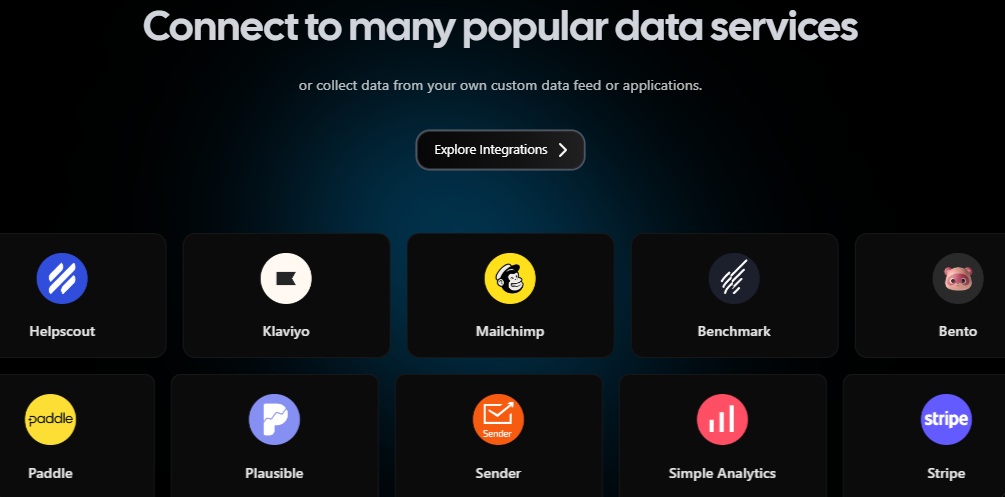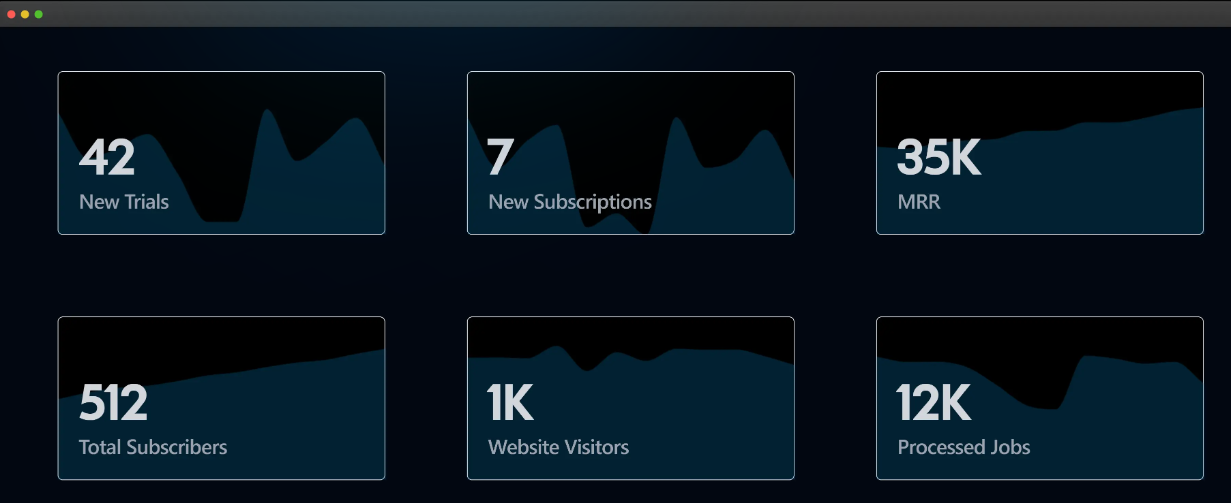What we cover in this article
Discover essential business metrics for success in this guide, covering financial, customer, operational, market, and innovation metrics. Learn to set goals, use reliable data, and automate tracking for informed decision-making. Enhance your business performance with Minimal Dashboard's real-time analytics. Visit the blog for more insights.
Contents
- Introduction
- Wondering Which Business Metrics to Prioritize For Success?
- Why Listen to Us?
- What are Business Metrics?
- 5 Essential Business Success Metrics Every Entrepreneur Should Track
- Best Practices in Tracking Business Success Metrics
- Ready to Streamline Tracking Your Business Success Metrics?
Introduction
This guide highlights essential business metrics for entrepreneurs to monitor, including financial, customer, operational, market, and innovation metrics. It emphasizes the importance of tracking these metrics for informed decision-making and long-term success. Best practices such as setting clear goals, using reliable data, and leveraging automation are discussed. Visit the Minimal Dashboard blog for additional insights on tracking business metrics.
Wondering Which Business Metrics to Prioritize For Success?
Running a small business can often feel like walking a tightrope—one misstep can lead to financial instability and lost opportunities.
Many entrepreneurs struggle with uncertainty, juggling multiple tasks while trying to pinpoint what truly drives success.
In this Minimal Dashboard guide, we will explore five essential metrics that every entrepreneur should monitor to navigate their business toward lasting success.
But first…
Why Listen to Us?
At Minimal Dashboard, we simplify the tracking of business success metrics by aggregating data from multiple sources into a unified, real-time dashboard. With our expertise in data integration, we recognize the key metrics that are crucial for achieving business success.

What are Business Metrics?
Business metrics are quantifiable measures used to evaluate the performance, health, and success of a business. They help organizations track their progress toward specific goals and objectives, enabling data-driven decision-making. The importance of tracking business metrics include:
- Performance Monitoring: Help identify how well a business is performing against its goals.
- Informed Decision-Making: Provide data that can guide strategic planning and operational improvements.
- Goal Setting: Enable businesses to set specific, measurable objectives.
- Trend Analysis: Help in understanding historical performance and forecasting future outcomes.
5 Essential Business Success Metrics Every Entrepreneur Should Track
1. Financial Metrics
Financial metrics are the backbone of any business, providing insight into its financial health and stability. These metrics help entrepreneurs understand their revenue, profit, and cash flow, which are crucial for maintaining a thriving business.
Let’s take a closer look at some of the most important financial metrics.
Revenue Growth
Revenue Growth is a critical metric that tracks the increase in sales over time. It is often calculated on a monthly, quarterly, or annual basis to provide a clear picture of a company’s financial trajectory. Monitoring revenue growth helps businesses:
- identify trends
- assess their overall performance
- spot potential challenges or opportunities early
Minimal Dashboard makes tracking revenue growth seamless, allowing entrepreneurs to visualize trends and make informed decisions about expanding product lines, entering new markets, and adjusting strategies to meet customer needs.
By understanding how revenue changes, entrepreneurs can make informed decisions about
- expanding their product lines
- entering new markets
- adjusting their strategies to better meet customer needs.
Profit Margin
Profit Margin measures how much of the revenue is actual profit after all expenses have been deducted. This metric is essential for evaluating a business’s profitability and operational efficiency.
There are several types of profit margins, including:
- Gross profit margin: it indicates the profit made after deducting the cost of goods sold
- Operating profit margin: it considers operating expenses; and net profit margin, which accounts for all expenses and taxes.
Each type provides valuable insights into different aspects of a company’s financial performance, helping entrepreneurs identify areas for cost reduction and efficiency improvements.
Cash Flow
Cash Flow indicates the liquidity of a business and its ability to cover expenses, reinvest in the business, and provide returns to shareholders.
Positive cash flow:
- ensures that a company can meet its financial obligations, such as payroll and supplier payments
- helps seize growth opportunities without relying heavily on external financing.
With Minimal Dashboard, entrepreneurs can monitor cash flow in real-time, allowing them to anticipate future financial needs and plan accordingly. Tools like cash flow forecasting integrated into the dashboard simplify the management of financial health, especially for startups and small businesses.

Return on Investment (ROI)
The ROI evaluates the profitability of investments by comparing the return to the initial investment cost. This metric helps businesses determine the effectiveness of their investments—be it in:
- marketing campaigns
- new product development
- infrastructure
The ROI also helps you allocate resources efficiently. By measuring ROI, entrepreneurs can make informed decisions about where to invest their time and money, focusing on initiatives that offer the greatest potential returns and aligning with long-term business goals.
Customer Acquisition Cost (CAC)
The CAC represents the cost associated with acquiring a new customer, including advertising, marketing, and sales expenses. This metric is crucial in understanding the efficiency of marketing efforts and ensuring a healthy balance between customer acquisition and profitability.
By optimizing CAC, businesses can maximize their return on marketing investments and ensure that they are not overspending to gain new customers. A lower CAC often indicates a more efficient customer acquisition process and can lead to higher overall profitability.
Using Minimal Dashboard, businesses can analyze CAC trends over time, enabling them to refine their marketing strategies and reduce overspending while attracting new customers.
Lifetime Value (LTV)
The LTV is the total revenue a business expects to generate from a single customer over the duration of their relationship. This metric helps businesses understand the long-term value of their customers. It also helps develop strategies to increase customer retention through initiatives like:
- loyalty programs
- personalized marketing
- superior customer service
A higher LTV indicates a loyal customer base and increased revenue potential, allowing businesses to justify higher acquisition costs and invest more in nurturing customer relationships.
Understanding LTV can also guide pricing strategies and product development, ensuring that offerings meet customer needs and expectations.
2. Customer Metrics
Customer metrics provide insights into customer satisfaction and loyalty. These metrics are essential for understanding how well a business meets its customers’ needs and expectations. Let’s explore some key customer metrics that can help businesses improve their customer relationships.
Customer Satisfaction (CSAT)
The CSAT measures how happy customers are with a product or service, typically using surveys that ask customers to rate their overall satisfaction with various aspects of their experience. This metric is crucial for identifying areas where a business can improve its offerings, such as:
- product quality
- customer service
- user experience
By focusing on customer satisfaction, businesses can increase retention, as satisfied customers are more likely to stay loyal, and generate positive word-of-mouth referrals, which can attract new customers and enhance brand reputation.
With Minimal Dashboard, businesses can aggregate CSAT scores from various platforms into one unified dashboard, making it easier to identify areas for improvement in product quality and customer service.

Net Promoter Score (NPS)
The NPS gauges customer loyalty by asking customers how likely they are to recommend your business to friends or colleagues, usually on a scale from 0 to 10. To help businesses understand the strength of their customer loyalty, respondents are categorized into:
- Promoters
- Passives
- Detractors
A high NPS indicates strong customer loyalty and a satisfied customer base, suggesting that customers are not only happy but also willing to advocate for the brand. By tracking NPS over time, businesses can identify areas for improvement in their customer relationship strategies and foster long-lasting relationships with their customers.
Churn Rate
Churn Rate is the percentage of customers lost during a specific period, calculated by dividing the number of customers lost by the total number of customers at the beginning of the period. This metric provides insight into customer retention and helps businesses identify potential issues affecting customer loyalty, such as:
- product dissatisfaction
- better competitor offerings
- inadequate customer service
See our list of top SaaS metrics every business must track.
By understanding and addressing the reasons behind churn, businesses can:
- make strategic changes to reduce it
- maintain a stable customer base
- ensure long-term success
- increase revenue
- achieve stronger market position
Minimal Dashboard offers tools for analyzing churn rates alongside customer feedback and other metrics, enabling businesses to pinpoint potential issues affecting customer loyalty.
3. Operational Metrics
Operational metrics assess the efficiency and effectiveness of a business’s operations. These metrics help businesses optimize their processes and improve overall performance. Let’s take a closer look at some essential operational metrics.
Productivity
Productivity measures output per employee or department, providing insights into how efficiently a business operates. Examples include:
- sales per employee
- units produced per hour
- number of customers served per day
By monitoring productivity, businesses can identify areas for improvement and make necessary changes to increase efficiency and reduce costs.
Efficiency Ratio
The Efficiency Ratio compares operating costs to revenue, assessing cost-effectiveness. This metric helps businesses understand their operational efficiency and identify areas where they can reduce costs. By improving the efficiency ratio, businesses can increase profitability and sustain growth.
With Minimal Dashboard, businesses can monitor their efficiency ratio alongside other key metrics, facilitating strategic decision-making for cost reduction.
Quality Metrics
Quality metrics track defects, errors, or product/service quality. Examples include:
- customer satisfaction score
- number of product returns
- percentage of errors in production
These metrics are vital for maintaining high standards and ensuring customer satisfaction. By monitoring quality metrics, businesses can identify areas for improvement and enhance their offerings.
4. Market Metrics
Market metrics provide insights into a business’s position within its industry and its ability to attract and retain customers. Let’s explore some key market metrics that can help businesses understand their competitive landscape.
Market Share
The Market Share is the percentage of an industry’s total sales that your company captures. This metric helps businesses understand their competitive position and identify opportunities for growth.
By increasing market share, businesses can expand their reach and strengthen their brand.
Customer Retention Rate (CRR)
The CRR measures how effectively a business keeps customers over time. A high retention rate indicates strong customer loyalty and a successful business model. By focusing on customer retention, businesses can ensure long-term success and profitability.
With Minimal Dashboard, businesses can analyze retention metrics alongside customer feedback to enhance their retention strategies and ensure long-term success.
5. Innovation Metrics
Innovation metrics assess a business’s ability to develop new products and services. These metrics help businesses stay competitive and adapt to changing market conditions. Let’s take a closer look at some essential innovation metrics.
Time to Market
Time to Market measures the speed at which a product moves from idea to launch. This metric helps businesses understand their ability to develop and deliver new products quickly. By reducing time to market, businesses can stay ahead of the competition and capitalize on new opportunities. The ideal Time to Market varies by industry and product type. For example, technology companies may have shorter timeframes compared to manufacturing companies.
R&D Spending
R&D Spending represents the investment in innovation, providing insights into a company’s commitment to research and development. This metric helps businesses assess their focus on innovation and identify areas for growth. By investing in R&D, businesses can ensure long-term success and competitiveness.
Minimal Dashboard can integrate R&D spending data alongside performance metrics, offering a comprehensive view of how innovation efforts impact overall business success.
Best Practices in Tracking Business Success Metrics
Set Clear Goals
Businesses should establish clear goals and objectives for each metric. By defining what success looks like, businesses can ensure that they are tracking the right metrics and focusing on what’s most important. This clarity helps businesses stay on track and achieve their goals.
Use Reliable Data
Utilizing reliable data sources and tools to track metrics is essential. Accurate data is vital for making informed decisions, and using dependable tools ensures that businesses can access and analyze their data effectively. Investing in quality data sources and tools, like Minimal Dashboard, can optimize tracking efforts by consolidating multiple data feeds into a single, accessible dashboard.
Regularly Review Metrics
Continuously review and update their metrics to ensure they remain relevant and aligned with their goals. By continuously monitoring and adjusting their metrics, businesses can stay responsive to changes in their market and make data-driven decisions.
Leverage Automation
Utilizing automation tools can greatly enhance the efficiency of tracking business success metrics. Automation minimizes manual data entry, reduces the risk of human error, and allows for real-time updates on key metrics. With Minimal Dashboard, businesses can automate data aggregation from various sources, providing a real-time view of performance and freeing up valuable time for teams to focus on strategic initiatives.
Ready to Streamline Tracking Your Business Success Metrics?
By understanding and monitoring the metrics outlined in this guide, businesses can make informed decisions, optimize their operations, and ensure long-term success. Minimal Dashboard stands out as a powerful tool for tracking and analyzing these success metrics.
With its user-friendly interface and advanced analytics features, Minimal Dashboard empowers businesses to make data-driven decisions and enhance their performance.
Ready to take the next step? Get started with Minimal Dashboard today!
